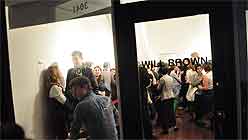Will Brown is not what, or who, you think it/he is. First of all, the art space is not actually operated by anyone named Will Brown. Started last year, it is run by the artists and curators Lindsey White, David Kazprzak and Jordan Stein. Second, it is not really a gallery, as often presumed; the Mission-based art space functions as more of a “micro-museum,” curating thematic, rather than commercial, exhibitions.
Founded in January of this year, Will Brown occupies the storefront on 24th and Treat that was formerly in use by Triple Base Gallery. After that gallery closed their doors in December of last year, its directors offered their lease to White. “It sort of fell in our laps,” says Kazprzak, and the group had to move quickly. Usually galleries (and even alternative spaces) are formed over long stretches of time, during which potential gallerists generate capital, gather a stable of artists, and exhaustively hunt for real estate. The genesis of Will Brown happened a bit in reverse: only after White, Kazprzak and Stein agreed to be collaborators, and signed the lease, did they begin to conceive of their mission for the space. It was a process, says Stein, “of reverse combustion.” In deciding what they wanted out of their communal project, the group had a lot of conversations about what they felt was missing in the San Francisco art community. During their first meeting, “which consisted of burritos and beers in Lindsey’s kitchen,” says Stein, a common ethos surfaced. Above all, the three friends didn’t want to “represent artists or show ‘art’ in the traditional, [commercial] sense,” says White. Rather, they were interested in engaging a community dialogue that wasn’t afraid to be playful.

David Kazprzak, Jordan Stein and Lindsey White
Their first show, Illegitimate Business, was a collaboration between Bay Area artists Zachary Royer Scholz and Brion Nuda Rosch. It explored — or debunked — the very function of the gallery itself, as each of the works on display (such as those from internationally renowned artists Kara Walker, Catherine Opie, and Andres Serrano) were obtained “without monetary exchange [and sometimes] illicitly.” Obviously, nothing in the show was for sale. Most recently, Will Brown’s April/June show, Manitoba Museum of Finds Art recreated a little-known “fictional museum.” Originally organized by Alberta Mayo in the waiting room of the SFMOMA Director Henry Hopkins in 1975, the MMOFA was comprised of ephemera and artworks both found and made. Both of these shows perfectly encompass Will Brown’s value system: to present interesting and engaging art that refuses the standardized (and often exclusive) conventions of commercial display and value.

Will Brown is not limited to art exhibitions, and has also held a number of events including, but not limited to: a Goth dance party; a figure drawing/comedy stand-up night; book and magazine launches; live performances, lectures and demonstrations by artists Chris Duncan, Jon Porras, Andy Vogt, The Post Brothers, and Tony Discenza. Those events help raise funds, though Will Brown’s principal support comes from its “Supportfolio,” a limited edition box set of photographs by Gregory Halpern, Dru Donovan, Sean McFarland, and Emily Prince.



